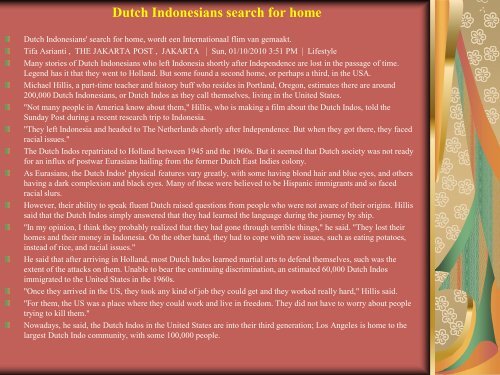Klik hier voor 20e editie februari 2010 - Indo Privé
Klik hier voor 20e editie februari 2010 - Indo Privé
Klik hier voor 20e editie februari 2010 - Indo Privé
Create successful ePaper yourself
Turn your PDF publications into a flip-book with our unique Google optimized e-Paper software.
Dutch <strong>Indo</strong>nesians search for homeDutch <strong>Indo</strong>nesians' search for home, wordt een Internationaal flim van gemaakt.Tifa Asrianti , THE JAKARTA POST , JAKARTA | Sun, 01/10/<strong>2010</strong> 3:51 PM | LifestyleMany stories of Dutch <strong>Indo</strong>nesians who left <strong>Indo</strong>nesia shortly after Independence are lost in the passage of time.Legend has it that they went to Holland. But some found a second home, or perhaps a third, in the USA.Michael Hillis, a part-time teacher and history buff who resides in Portland, Oregon, estimates there are around200,000 Dutch <strong>Indo</strong>nesians, or Dutch <strong>Indo</strong>s as they call themselves, living in the United States."Not many people in America know about them," Hillis, who is making a film about the Dutch <strong>Indo</strong>s, told theSunday Post during a recent research trip to <strong>Indo</strong>nesia."They left <strong>Indo</strong>nesia and headed to The Netherlands shortly after Independence. But when they got there, they facedracial issues."The Dutch <strong>Indo</strong>s repatriated to Holland between 1945 and the 1960s. But it seemed that Dutch society was not readyfor an influx of postwar Eurasians hailing from the former Dutch East Indies colony.As Eurasians, the Dutch <strong>Indo</strong>s' physical features vary greatly, with some having blond hair and blue eyes, and othershaving a dark complexion and black eyes. Many of these were believed to be Hispanic immigrants and so facedracial slurs.However, their ability to speak fluent Dutch raised questions from people who were not aware of their origins. Hillissaid that the Dutch <strong>Indo</strong>s simply answered that they had learned the language during the journey by ship."In my opinion, I think they probably realized that they had gone through terrible things," he said. "They lost theirhomes and their money in <strong>Indo</strong>nesia. On the other hand, they had to cope with new issues, such as eating potatoes,instead of rice, and racial issues."He said that after arriving in Holland, most Dutch <strong>Indo</strong>s learned martial arts to defend themselves, such was theextent of the attacks on them. Unable to bear the continuing discrimination, an estimated 60,000 Dutch <strong>Indo</strong>simmigrated to the United States in the 1960s."Once they arrived in the US, they took any kind of job they could get and they worked really hard," Hillis said."For them, the US was a place where they could work and live in freedom. They did not have to worry about peopletrying to kill them."Nowadays, he said, the Dutch <strong>Indo</strong>s in the United States are into their third generation; Los Angeles is home to thelargest Dutch <strong>Indo</strong> community, with some 100,000 people.
















